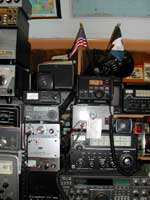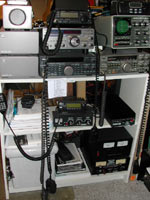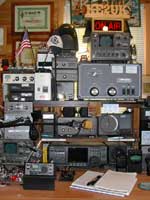|
CQ CQ CQ Any Station Any Station Any Station
The Auxiliary is looking for Amateur Radio Operators
By Wayne Spivak - KC2NJV
National Press Corps
United States Coast Guard Auxiliary
Photos by Ron Tomo - KE2UK
United States Coast Guard Auxiliary
To an individual involved in Amateur Radio, also known as Ham Radio, the letters CQ sent via voice or Morse Code is a request by the sender to talk to anyone listening on the frequency. Simply, the sending party is looking for a pleasant conversation. Conversations is what Ham Radio is all about, whether its with someone down the block, across town or on the other side of the world.
Well, the USCG Auxiliary is calling, and we’re looking for a dialogue with those citizens who are or want to be Ham Radio Operators. Like every other emergency based service, the Coast Guard operates every day, in good weather and in bad. We, in the USCG Auxiliary operate whether there is power to operate the normal modes of communication, such as phones, or whether the weather is bad, and the normal means of communications are out of service.
|
Inside the AUXNET Mobile Communication Center are Marine VHF radios, AUXNET radios, cellphones, 2m Ham Radios
(click images to enlarge) |
|
It is these times that the Coast Guard and Coast Guard Auxiliary rely on the Auxiliary Net (AuxNet), a back-up radio net (group of qualified radio operators and radios) who maintain communications with both the Auxiliary and the Coast Guard. The AuxNet operates in both times of emergency and in regular everyday situations.
In some areas, where there is no regular Coast Guard presence, the Auxiliary relies solely on their AuxNet for communications. In areas where there is even a large presence of Coast Guard facilities, the AuxNet operates in both a support and back-up mode, becoming a facilitator of the Auxiliary mission.
|
A look at some of the myriad equipment at the Bellmore, NY Auxiliary Emergency Communications Station. |
 |
|
Why Hams?
Where does Ham Operators fit into the emergency services provided by the Auxiliary and the Coast Guard?
Ham operators are good communicators. They have developed skills sets, in both every day radio communications, as well as emergency communications, through such organizations as Radio Amateur Civil Emergency Service (RACES), the Amateur Radio Emergency Service (ARES) and the National Weather Services (NWS)’ SKYWARN.
These organizations both work with the Federal Emergency Management Agency (FEMA) during national or large based emergencies, as well as local and regional disaster agencies. In the case of RACES, it is managed through FEMA while the ARES program is managed though the American Radio Relay League (ARRL). As mentioned earlier, SKYWARN is a NWS sponsored activity.
|
Part of the Bellmore Radio Antenna Farm
|
|
The Amateur Radio Operators who volunteer for these services receive extra training and practice their skills in drills, waiting for that one event which may never come, to put their skill set into action. Auxiliarists use their skills every time they don their uniform and begin a mission.
The Auxiliary is always interested in individuals with unique skill sets. Amateur Radio Operators are these types of individuals.
So, why join the Auxiliary instead of the other traditional disaster or emergency services for Amateur Radio Operators?
There are several reasons. Chief among these (and as already stated) is the ability to exercise in real time those skill sets that are utilized in emergency response on a more frequent non-drill basis.
|
More Radios at the Bellmore, NY Auxiliary Emergency Communications Station. - These are mostly Marine VHF and 2m Ham Band radios |
 |
|
Remember - Auxiliarists work every day, in the real world. Whether its doing a Maritime Domain Awareness (MDA) patrol via vehicle, and needing two-way communications with the Coast Guard, or a Safety Patrol, or even assisting at major events like Fleet Week or the national political conventions, as just happened in both Boston and New York. Most of these types of events are daily on-going missions. While Fleet Week comes once a year in some of our major port cities, and the political conventions happen every four years (and may not be in a port city), MDA patrols and safety patrols are done daily, in every part of the US.
Communication and good communicators are at the heart of any successful mission, and Ham Operators have the experience that the Auxiliary is both looking for and would like to instill in their current communicators.
|
The USCG Auxiliary Mobile Communication Vehicle |
|
Qualified Ham Operators can become instructors, teaching non-Ham operators the techniques and skills that will make them skilled radio operators.
Want to help?
Joining the Auxiliary does not limit the Auxiliarist to a single functional area. All areas and missions are open to all Auxiliarists. While the Ham Operator will still need some training in Coast Guard/Auxiliary communications, the time to obtain the minimal qualification for these individuals would be short. Other qualifications, in such areas as Boat Crew, Marine Safety and Aviation take longer to obtain.
|
More Radios at the Bellmore, NY Auxiliary Emergency Communications Station. These are mostly HF Ham radios. |
 |
|
The United States Coast Guard Auxiliary is open to all US citizens over the age of 17. A security background check is required (paid by the Coast Guard) before the applicant is accepted.
For more information, why not contact your local Auxiliary Flotilla. You can make contact by either calling your local Coast Guard Station or finding the Flotilla on the web at our Flotilla Finder.
|

